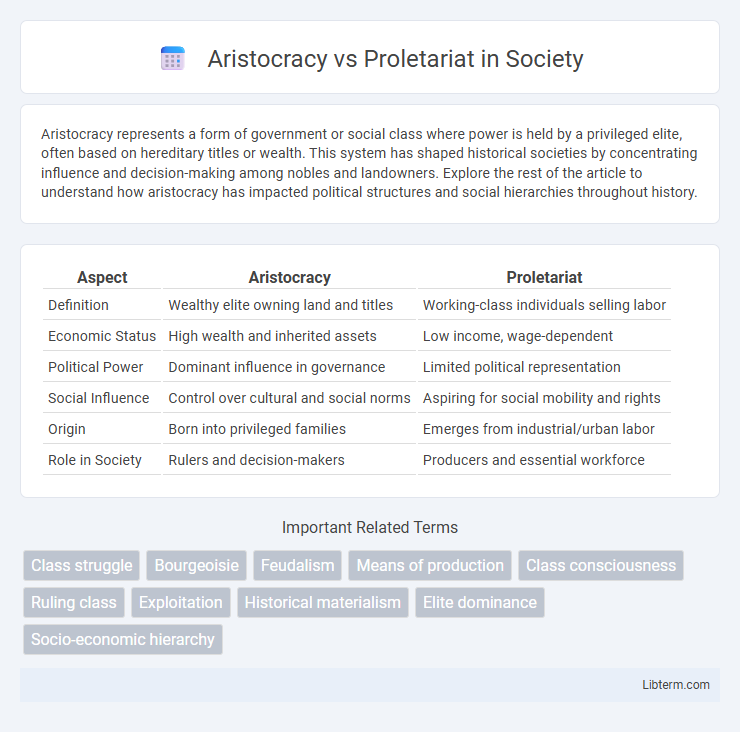Aristocracy represents a form of government or social class where power is held by a privileged elite, often based on hereditary titles or wealth. This system has shaped historical societies by concentrating influence and decision-making among nobles and landowners. Explore the rest of the article to understand how aristocracy has impacted political structures and social hierarchies throughout history.
Table of Comparison
| Aspect | Aristocracy | Proletariat |
|---|---|---|
| Definition | Wealthy elite owning land and titles | Working-class individuals selling labor |
| Economic Status | High wealth and inherited assets | Low income, wage-dependent |
| Political Power | Dominant influence in governance | Limited political representation |
| Social Influence | Control over cultural and social norms | Aspiring for social mobility and rights |
| Origin | Born into privileged families | Emerges from industrial/urban labor |
| Role in Society | Rulers and decision-makers | Producers and essential workforce |
Defining Aristocracy and Proletariat
Aristocracy refers to a social class characterized by hereditary nobility, wealth, and political influence, often owning significant land and resources. The proletariat constitutes the working class, primarily employed in industrial labor and lacking ownership of production means, relying on wages for survival. These two classes define contrasting social and economic roles within capitalist societies, highlighting disparities in power and wealth distribution.
Historical Origins of the Aristocracy
The aristocracy emerged historically from feudal societies where land ownership and hereditary titles defined social hierarchy, consolidating power among privileged classes. These elites controlled political authority, economic resources, and military forces, often justifying their dominance through birthright and divine sanction. In contrast to the proletariat, who comprised wage laborers without property, the aristocracy's origins are rooted in medieval European structures that institutionalized social stratification and class privileges.
Emergence of the Proletariat Class
The emergence of the proletariat class marked a pivotal shift during the Industrial Revolution, characterized by the mass migration of workers into urban factories where they sold their labor for wages. This new working class challenged the traditional aristocracy's dominance, as economic power gradually shifted from landownership to industrial capital. The proletariat's growing numbers and collective consciousness laid the groundwork for labor movements demanding political representation, better working conditions, and social reforms.
Economic Power and Class Distinctions
Economic power in aristocracy is concentrated in land ownership, inherited wealth, and control over political influence, creating entrenched class distinctions that privilege a small elite. The proletariat, composed of working-class individuals, relies primarily on wage labor with limited access to capital, resulting in economic dependency and social mobility constraints. This stark division establishes a persistent hierarchy where aristocratic interests dominate economic resources and shape societal structures.
Political Influence and Social Roles
Aristocracy wields significant political influence through hereditary privileges, land ownership, and control of legislative bodies, reinforcing their dominant social roles as policymakers and elite leaders. The proletariat, composed of working-class individuals, holds minimal formal political power, often engaging in collective action and labor movements to challenge existing hierarchies and advocate for social reforms. These contrasting social roles underscore the systemic power imbalance between aristocratic elites and the proletarian masses in governance and societal structure.
Cultural Values and Class Identity
Aristocracy emphasizes tradition, heritage, and exclusivity, fostering a sense of cultural superiority through inherited status and refined tastes in art, literature, and etiquette. The proletariat centers its cultural values on solidarity, resilience, and collective identity, often expressing themselves through grassroots art, music, and social movements that challenge established power structures. Class identity in the aristocracy is defined by lineage and privilege, while in the proletariat, it is rooted in shared labor experiences and aspirations for social mobility and equality.
Key Conflicts Between Aristocracy and Proletariat
The key conflicts between aristocracy and proletariat center on economic disparity and political power struggles, where the aristocracy controls wealth, land, and inheritance, while the proletariat relies on labor and wages for survival. Ideological clashes arise from the aristocracy's desire to maintain traditional privileges and social hierarchies, contrasted with the proletariat's push for equality, workers' rights, and social reform. These tensions often manifest in class conflicts, labor strikes, and revolutionary movements aimed at redistributing wealth and dismantling aristocratic dominance.
Impact on Social Mobility
The aristocracy traditionally controls wealth and political power, creating rigid social hierarchies that limit upward mobility for lower classes. In contrast, the proletariat, consisting largely of working-class individuals, faces structural barriers that hinder economic advancement despite labor contributions. These entrenched class divisions significantly impact social mobility by sustaining inequality and restricting access to education, resources, and influential networks.
Modern Relevance of Class Struggles
Class struggles between the aristocracy and the proletariat remain relevant in modern society as economic inequality and social mobility continue to shape political discourse worldwide. The concentration of wealth and power among elite groups mirrors historical aristocratic dominance, while the working class fights for fair wages, labor rights, and access to education. Contemporary movements advocating for economic justice highlight ongoing tensions rooted in class divisions that drive systemic change.
Bridging the Gap: Paths Toward Equality
Bridging the gap between aristocracy and proletariat requires systemic reforms that promote wealth redistribution and equal access to education, healthcare, and political representation. Progressive taxation and social welfare programs empower the working class while mitigating entrenched privileges of the elite. Policies fostering economic mobility and inclusive governance create pathways toward a more equitable and cohesive society.
Aristocracy Infographic

 libterm.com
libterm.com